Welcome a discovery of enchanting red-flowering trees! Get ready to be captivated by nature’s stunning display of vibrant crimson hues. From the delicate blossoms to the majestic canopies, these awe-inspiring trees will add a touch of elegance and splendor to any landscape.
Red-flowering trees are a great way to bring beauty and color to your landscape. The vibrant hue of red is sure to draw attention and make any outdoor space stand out in the crowd. Red flowering trees can be used as focal points, borders, or accents for your garden or yard. Here are some of the most vibrant and popular varieties.

1. Flowering Dogwood
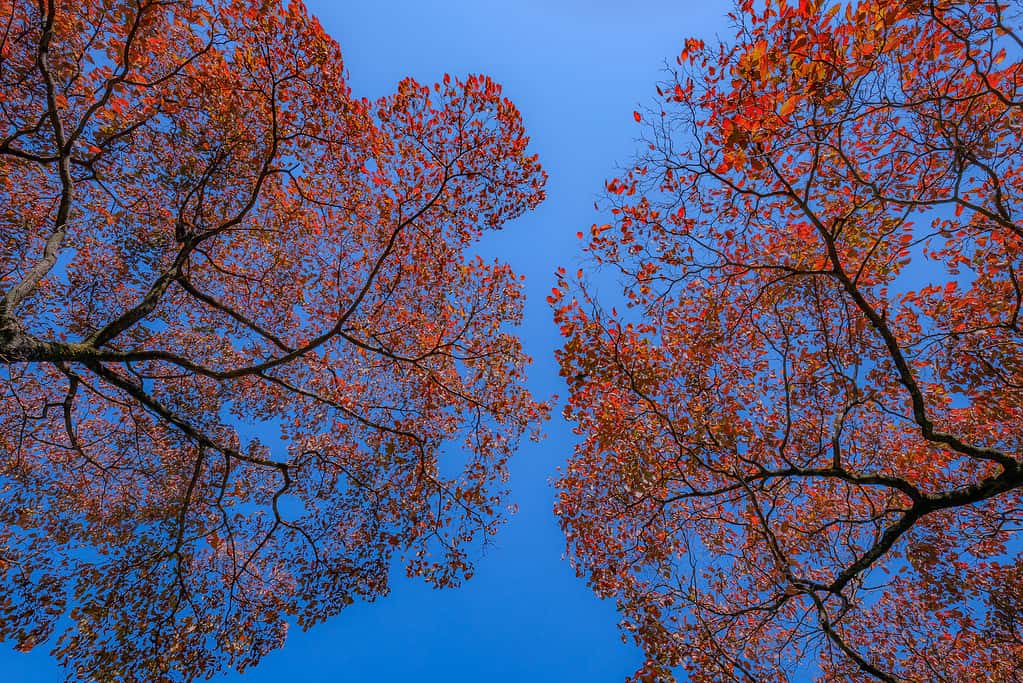
Red dogwood trees add a bright splash of color to the world.
©atonom/iStock via Getty Images
The red-flowering dogwood tree is a stunning sight to behold. It has a broad, rounded canopy and can reach heights of up to thirty feet tall. Its flowers are small and have four white petals with a cluster of red or pink in the center. It prefers partial sun, and because of this, it is often used for woodland gardens.
This tree also provides a food source for many species of wildlife, such as butterflies, bees, and other pollinators. Its colorful flowers attract these animals, helping to promote pollination of other plants in the area. The red-flowering dogwood tree also has small drupes that provide food for birds and other small animals.
In addition to being an attractive landscape tree, the red-flowering dogwood helps restore disturbed habitats. Its shade and berries can attract wildlife like birds, and its large root system can help stabilize the soil. Not only that, but the tree can help to reduce erosion and improve water quality.
2. Crepe Myrtle

What a perfect shade of red!
©Laurel Owen/iStock via Getty Images
The crepe myrtle tree is an attractive, deciduous tree that can reach heights of up to 30 feet. Its trunk and branches are light gray in color, and its foliage is a deep green. Its flowers are delicate and showy, with colors ranging from white to pink, purple, and red.
This tree requires full sun exposure and well-drained soil to reach its full potential. It is tolerant of adverse weather conditions and is a great choice for gardeners in many different climates.
Crepe myrtle trees are beneficial to many pollinators and wildlife. Bees love its flowers, and butterflies often flock to the tree. It provides a great food source for birds and small mammals as well.
3. Red Horse Chestnut

Blooming red
horse
chestnut trees (Aesculus carnea) are a joy to see every spring.
©OlyaSolodenko/iStock via Getty Images
The red horse chestnut tree is an impressive sight to behold. This majestic tree has a broad, domed crown and a trunk that can grow up to three meters in diameter. Its lush, dark green leaves are large and glossy, and its showy flowers range in color from deep red to white.
This tree flourishes in full sun and moist soil, making it an ideal choice for large yards and parks. It is popular among gardeners due to its beautiful foliage and flowers, and it also provides a home for a variety of wildlife. Hummingbirds, bees, and butterflies are drawn to its sweet-smelling blossoms, while many species of birds are attracted to its abundant fruit.
4. Red Maple
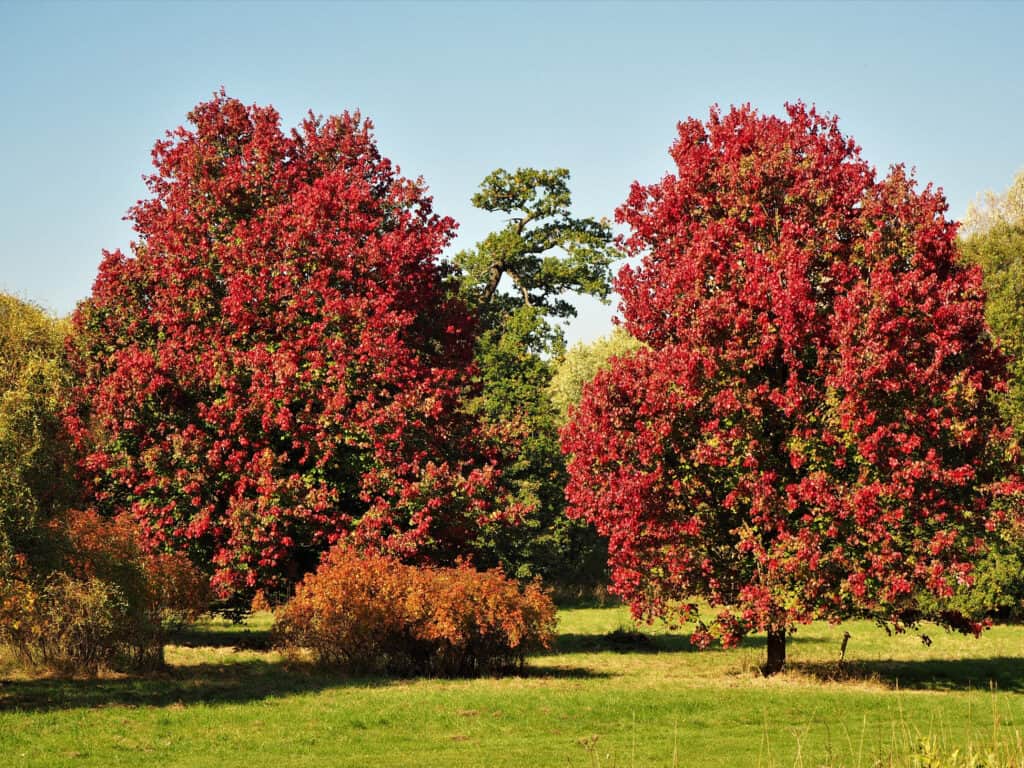
Red maple prefers moist soils.
©AngieC333/Shutterstock.com
The red maple tree is a beautiful sight to behold! This deciduous tree is easily recognizable by its lobed, dark green leaves, which turn a brilliant red in the fall. The red flowers are small, growing in clusters at the ends of the branches, usually appearing in spring. It can tolerate a wide range of sunlight conditions, from full sun to partial shade, making it a great choice for any garden.
Not only is the red maple tree an attractive addition to any landscape, but it also provides great benefits to wildlife. Its flowers provide a source of nectar for pollinators, such as bees and butterflies, while its seeds provide nourishment for birds. In addition, the tree’s dense foliage provides shelter and nesting sites for birds and other small animals.
5. Red Frangipani

The red-flowering plumeria, or frangipani, is a gorgeous tree for warmer climates.
©Qin Ningzhen/iStock via Getty Images
The red frangipani tree is a stunningly beautiful addition to any outdoor space. It grows to a height of around 6-10 feet, with glossy green leaves and a wide canopy that can provide shade. Its flowers are a vibrant red and provide a lovely contrast to the leaves.
The red frangipani tree prefers full sun to partial shade, making it a perfect choice for areas with lots of sunlight. It is also fairly drought tolerant, so it can survive during periods of little to no rain.
The red frangipani tree attracts a wide variety of birds, including finches, cardinals, bluejays, doves, and hummingbirds. Its flowers provide them with a source of nectar, and its seeds provide nourishment for these birds. In addition, the tree’s dense foliage provides shelter and nesting sites for birds and other small animals.
6. Chinese Hibiscus

This hibiscus has many common names, but one thing is for sure: the flowers are stunning.
©Ihor Hvozdetskyi/Shutterstock.com
The Chinese Hibiscus tree is an evergreen tree or small shrub that grows in tropical climates. It can grow up to ten feet tall and nearly 8 feet wide. Its leaves are dark green and glossy, and it produces bright and vibrant red flowers with five petals.
Chinese Hibiscus is a beautiful red flowering tree that requires full sun or partial shade and moist soil with proper drainage. It enjoys high humidity and protection from strong winds and frost. Plant the tree 12 feet apart in gardens, naturalized areas, or in containers. It has a medium rate of growth and needs regular pruning in early spring to maintain a compact shape. Since it is sensitive to environmental changes, moving the plant may cause leaf or bud drop. Propagation happens through stem cuttings. Its large-bloomed flowers are attractive to bees and other pollinators.
7. Magnolia
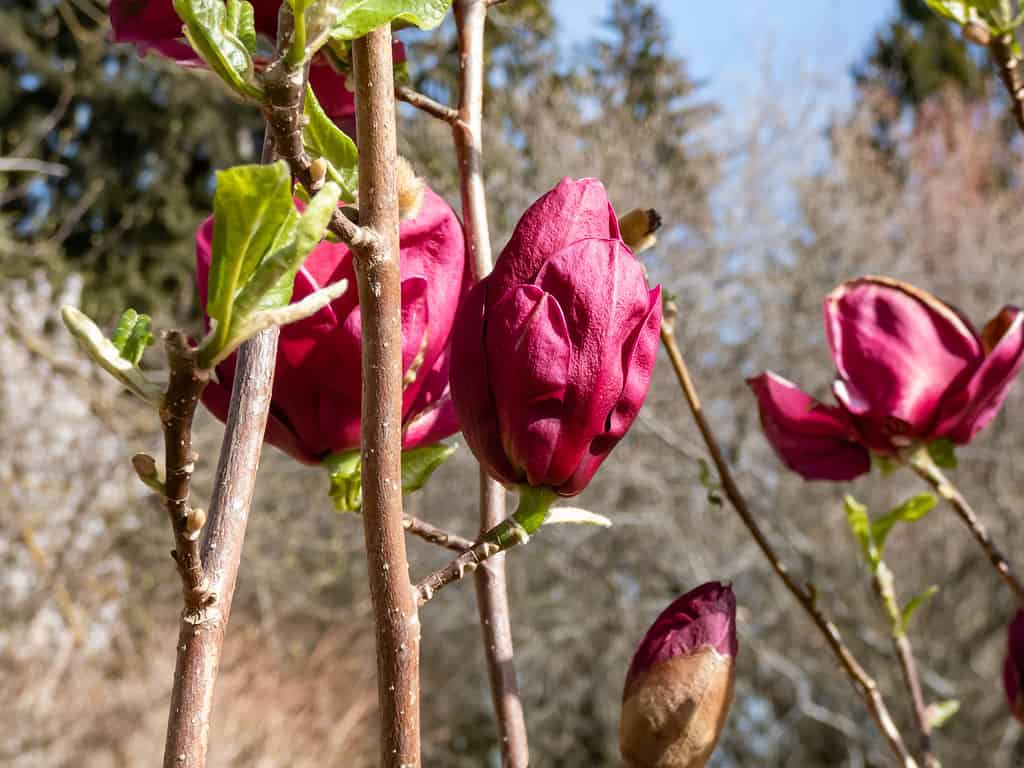
Magnolia ‘Genie’ has deep red buds that make for a stunning red-flowering tree.
©Kristine Radkovska/iStock via Getty Images
Growing a red-flowering magnolia tree is a rewarding experience. These trees are large, evergreen trees with glossy, dark green leaves that can reach 40 feet in height and spread up to 25 feet in diameter. The flowers of a red-flowering magnolia tree are vibrant red and can measure up to 10 inches in diameter. The petals are waxy, and the stamens are yellow. Red-flowering magnolia trees produce fragrant, cone-like fruits which contain a red seed inside.
These trees are relatively easy to care for and can be grown in a variety of climates. They need full sun and moist, well-drained soil in order to thrive. Pruning should be done in late winter or early spring to promote healthy growth. Apply fertilizers in the spring and late summer. Red-flowering magnolia trees can be susceptible to fungal diseases, so it’s important to keep the area around the tree clear of debris and to water at the base of the tree rather than from overhead.
8. Red Buckeye
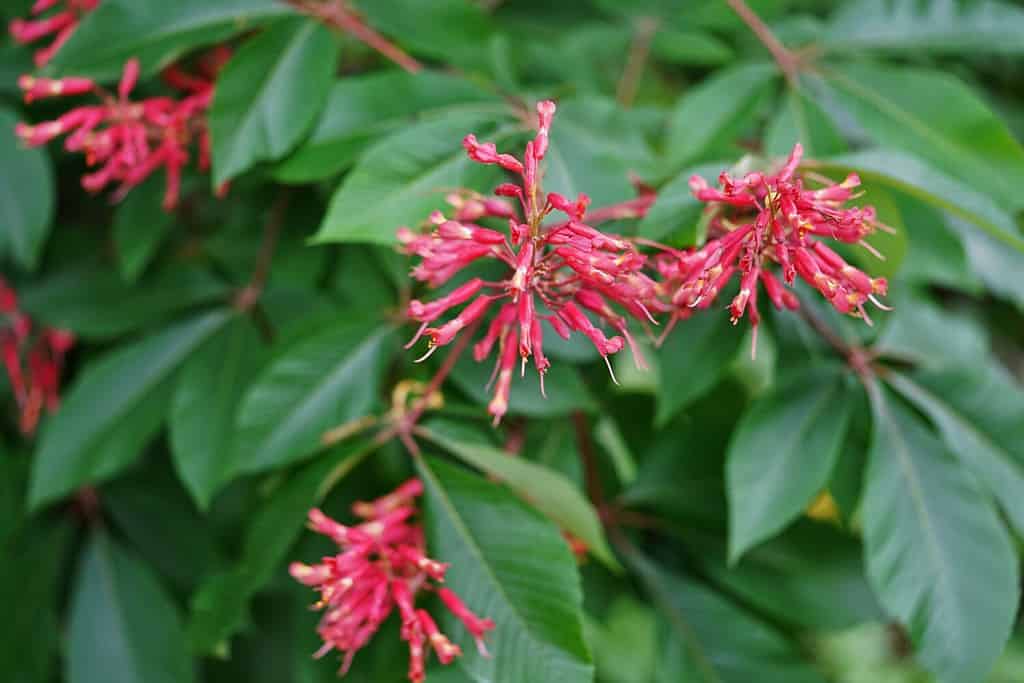
If you are looking for a red-flowering tree that is very easy to grow, consider a red buckeye.
©EQRoy/Shutterstock.com
Red buckeye trees are an attractive and low-maintenance addition to gardens. They grow between 15 and 25 feet tall and spread up to 20 feet, making them a great shade tree. The leaves are compound and made up of 5-7 leaflets. In the spring, the trees produce clusters of bright red-orange flowers. The blooms are around 3 inches wide and have five petals each.
Red buckeyes thrive in areas with full or partial sun. They can tolerate temperatures as low as -10 degrees Fahrenheit, making them a great choice for colder climates. Planting should be done in the spring or fall, allowing plenty of time for the tree to become established before winter. Red buckeyes do not need much maintenance, but they should be watered regularly during the first year.
9. Crimson Bottlebrush Tree
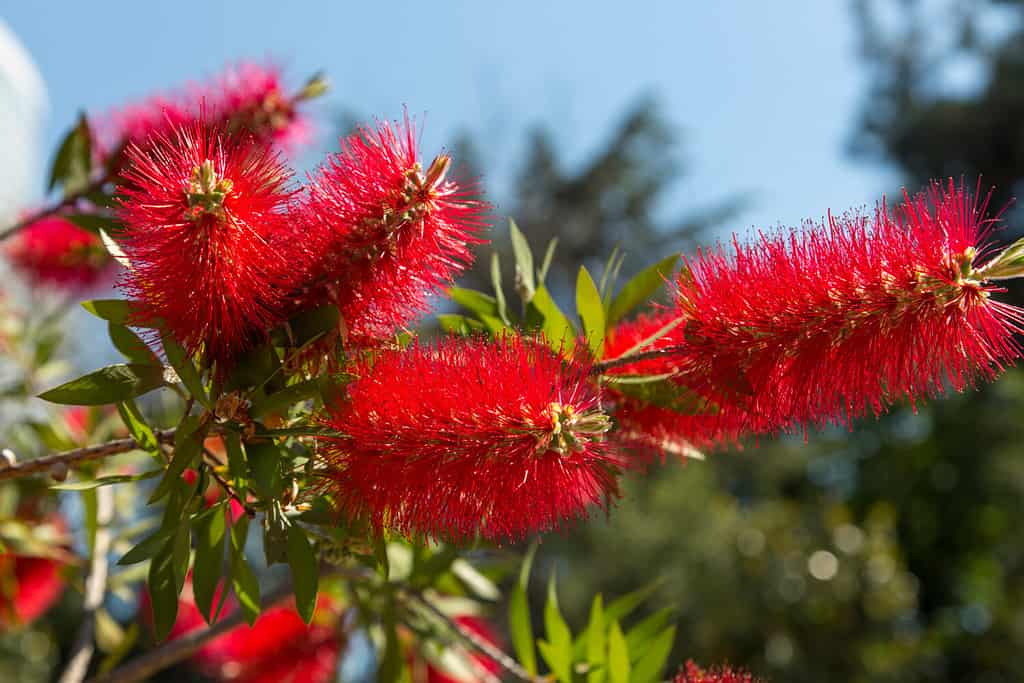
This very unique red-flowering tree is native to Australia.
©lucky eyes/Shutterstock.com
The crimson bottlebrush tree (Melaleuca citrina) is an evergreen tree native to Australia with unique and attractive characteristics. Growing a bottlebrush tree in your yard is a great way to add a splash of color and interest to your outdoor space.
The bottlebrush tree has an upright growth habit with a single trunk and a rounded canopy. It can reach heights of up to 30 feet and a width of 25 feet. Its foliage is dense and bright, with narrow, linear, bright-green leaves. In the spring, its branches are adorned with vibrant red blooms that look like bottle brushes, giving the tree its common name.
To successfully grow a bottlebrush tree, you’ll need to provide well-drained soil in a sunny spot in your yard. Water your tree regularly during its first few summers to help it establish a strong root system. Prune only as needed to remove dead branches or to shape the tree.
10. Rhododendron
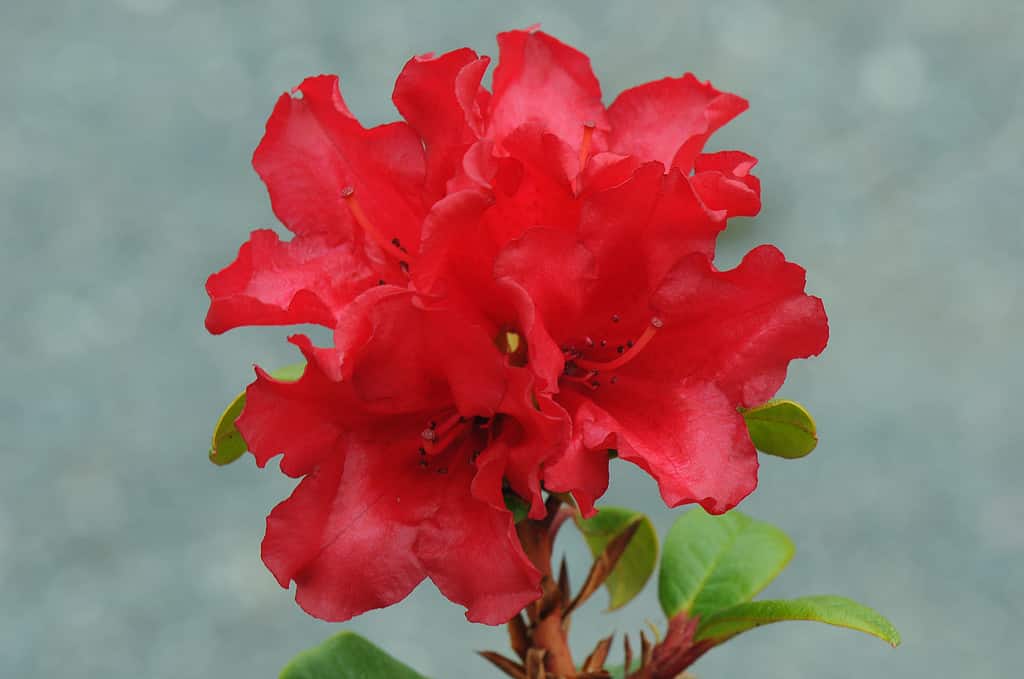
Red rhododendron flowers are the favorite of many bees and hummingbirds.
©Todd Boland/Shutterstock.com
A red-flowering rhododendron offers a stunningly beautiful addition to any outdoor garden. These plants can reach heights of up to 20 feet and produce large, vibrant blooms in a variety of colors. Growing a red-flowering tree rhodendron requires careful attention to its environment and a few simple steps.
First, you must choose a sunny area with well-draining soil and plenty of moisture. The plant prefers more acidic soil. Adding peat moss, compost, or other acidic materials will help. Plant the rhododendron in a hole twice as wide as the root ball, making sure to spread the roots out evenly. Cover the roots with soil and tamp them down gently.
Once planted, you can apply an acidic fertilizer and mulch around the base of the plant to help retain moisture and protect the roots. Water the rhododendron regularly, especially during hot and dry periods. Prune the plant occasionally to maintain its shape and promote healthy growth.
11. Royal Poinciana
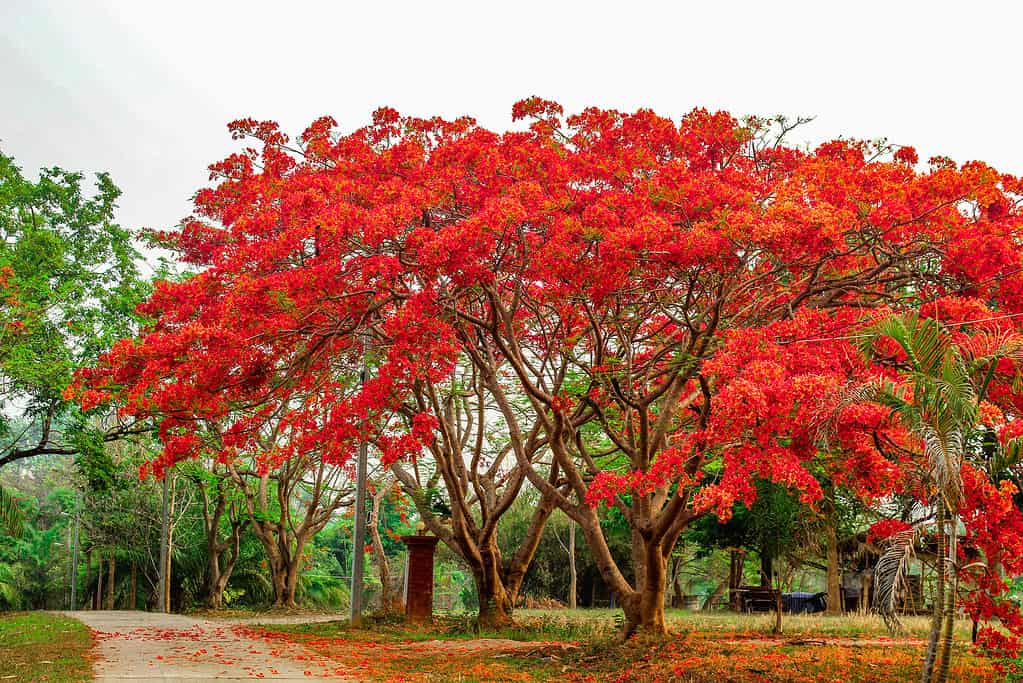
A poinciana tree is one of the most beautiful red-flowering trees in the world.
©Randall W Simpson/Shutterstock.com
Growing a royal poinciana tree (Delonix regia) can be a rewarding experience. It is a fast-growing, striking tree that adds a beautiful splash of color and unique foliage.
The royal poinciana tree is an evergreen tree that can reach heights of up to 40 feet. It has a large, rounded canopy and a wide-spreading, umbrella-like silhouette. Its large, thick leaves are a glossy green on the top side and a lighter green on the underside.
In Spring, this red-flowering tree bursts into bloom with an abundance of bright red flowers. These flowers are clustered together in long, drooping clusters, giving the tree a stunning display.
This tree has feathery foliage that looks a bit like a fern, adding to its interesting appearance. The seed pots are also unique and look a lot like pea pods. They brown and dry on the tree and are a favorite snack for many birds.
12. Red Silk Cotton Tree
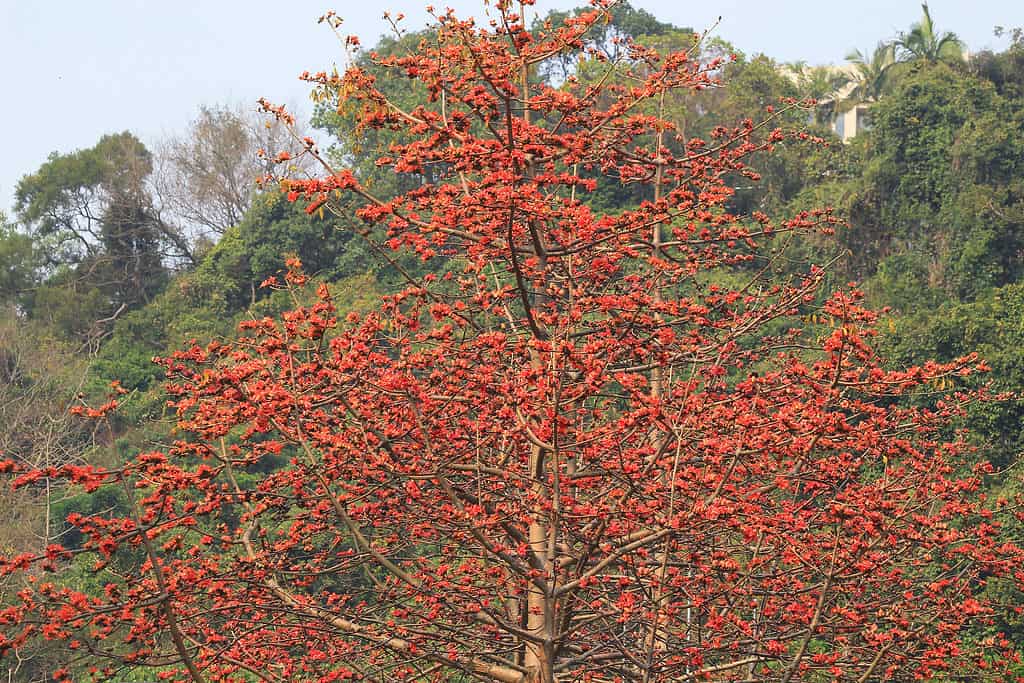
When in full bloom, a red silk cotton tree has thousands of flowers.
©seaonweb/Shutterstock.com
The red silk cotton tree, also known as Bombax ceiba, is a striking addition to any garden. Growing up to 70 feet tall, the tree has a broad, dense canopy of green leaves and a trunk that can reach up to two feet in diameter. Its most prominent feature, however, is its bright red flowers. These blossoms are made up of five petals that are arranged in an open cup shape.
Taking care of a red silk cotton tree is relatively easy. It prefers partial shade and needs to be planted in well-drained soil. During its first year, it should be watered regularly to ensure proper growth. Once established, the tree requires minimal maintenance and is drought-tolerant. Landscapers in Florida often use this tree in parks and public spaces.
The photo featured at the top of this post is © Laurel Owen/iStock via Getty Images
Thank you for reading! Have some feedback for us? Contact the AZ Animals editorial team.







